Thermo-Fluid–Structural Coupled Analysis of a Mechanical Seal in Extended Loss of AC Power of a Reactor Coolant Pump
Abstract
:1. Introduction
2. Method of Analysis
2.1. Lubrication Analysis in Fluid Film
2.2. Thermal Analysis in Fluid Film
2.3. Heat Conduction and Elastic Deformation of the Seal Structure
2.4. Numerical Algorithm
3. Numerical Verification
4. Results and Discussion
4.1. Analysis Model
4.2. Characteristics of a Mechanical Seal under Normal Operating Conditions
4.3. Characteristics of a Mechanical Seal under ELAP Operating Conditions
5. Conclusions
Author Contributions
Funding
Data Availability Statement
Conflicts of Interest
Nomenclature
| Dn | Total elastic deformation of all nodes at the n-th iteration |
| Fclose | Closing force [N] |
| Fopen | Opening force [N] |
| Gr | Fluid state coefficients for radial flow |
| Gθ | Fluid state coefficient for circumferential flow |
| h | Film thickness [mm] |
| hc | Minimum film thickness [mm] |
| hg | Groove depth [mm] |
| hd | Deformation amount [mm] |
| p | Pressure of fluid film [bar] |
| Temperature of fluid film [K] | |
| Fluid velocity [m/s] | |
| Weighting function | |
| Viscosity [Pa∙s] | |
| Density [kg/m3] | |
| Arbitrary vector | |
| Shape function vector | |
| Element pressure vector [bar] | |
| Element temperature vector [K] | |
| Ω | Interested domain |
| Rotating velocity [rad/s] | |
| Re | Reynolds number |
| Pr | Prandtl number |
| Nu | Nusselt number |
References
- Yang, J.H.; Wang, J.R.; Shih, C.; Huang, C.F.; Chen, S.W. The simulation and study of ELAP event with URG and FLEX mitigation strategies for PWR by using TRACE code. Kerntechnik 2019, 84, 72–83. [Google Scholar] [CrossRef]
- Thomas, S.; Brunetiere, N.; Tournerie, B. Numerical modeling of high pressure gas face seals. J. Tribol. 2006, 128, 396–405. [Google Scholar] [CrossRef]
- Thomas, S.; Brunetiere, N.; Tournerie, B. Thermoelastohydrodynamic behavior of mechanical gas face seals operating at high pressure. J. Tribol. 2007, 129, 841–850. [Google Scholar] [CrossRef]
- Brunetiere, N.; Thomas, S.; Tournerie, B. The parameters influencing high-pressure mechanical gas face seal behavior in static operation. Tribol. Trans. 2009, 52, 643–654. [Google Scholar] [CrossRef]
- Nyemeck, A.P.; Brunetiere, N.; Tournerie, B. A mixed thermoelastohydrodynamic lubrication analysis of mechanical face seals by a multiscale approach. Tribol. Trans. 2015, 58, 836–848. [Google Scholar] [CrossRef]
- Mosavat, M.; Moradi, R.; Takami, M.R.; Gerdroodbary, M.B.; Ganji, D.D. Heat transfer study of mechanical face seal and fin by analytical method. Eng. Sci. Technol. Int. J. 2018, 21, 380–388. [Google Scholar] [CrossRef]
- Su, H.; Rahmani, R.; Rahnejat, H. Thermohydrodynamics of bidirectional groove dry gas seals with slip flow. Int. J. Therm. Sci. 2016, 110, 270–284. [Google Scholar] [CrossRef]
- Su, W.; Liu, W.; Yan, L.; Zhang, Y. Thermal performances of the wave-tilt-dam seal in a reactor coolant pump for sustainable development. Sustain. Energy Technol. Assess. 2022, 52, 102042. [Google Scholar] [CrossRef]
- Brunetiere, N.; Tournerie, B.; Frene, J. TEHD lubrication of mechanical face seals in stable tracking mode: Part 1—Numerical model and experiments. J. Tribol. 2003, 125, 608–616. [Google Scholar] [CrossRef]
- Brunetiere, N.; Tournerie, B.; Frene, J. TEHD lubrication of mechanical face seals in stable tracking mode: Part 2—Parametric study. J. Tribol. 2003, 125, 617–627. [Google Scholar] [CrossRef]
- Brunetiere, N.; Rouillon, M. Fluid flow regime transition in water lubricated spiral grooved face seals. Tribol. Int. 2021, 153, 106605. [Google Scholar] [CrossRef]
- Mo, H.; Hu, Y.; Quan, S. Thermo-hydrodynamic lubrication analysis of slipper pair considering wear profile. Lubricants 2023, 11, 190. [Google Scholar] [CrossRef]
- Grun, H.; Feldmeth, S.; Bauer, F. Multiphase computational fluid dynamics of rotary shaft seals. Lubricants 2022, 10, 347. [Google Scholar] [CrossRef]
- Liu, Y.; Liu, W.; Li, Y.; Liu, X.; Wang, Y. Mechanism of a wavy-tilt-dam mechanical seal under different working conditions. Tribol. Int. 2015, 90, 43–54. [Google Scholar] [CrossRef]
- Galenne, E.; Pierre, D.I. Thermo-elasto-hydro-dynamic modeling of hydrostatic seals in reactor coolant pumps. Tribol. Trans. 2007, 50, 466–476. [Google Scholar] [CrossRef]
- Su, W.T.; Wang, Y.H.; Feng, X.D.; Li, X.B. Thermal-liquid–solid coupling characteristics of wavy-end-face mechanical seal for reactor coolant pump. Nucl. Eng. Des. 2023, 414, 112545. [Google Scholar] [CrossRef]
- Wang, J.L.; Chen, X.Y.; Binama, M.; Su, W.T.; Wu, J. A numerical study on mechanical seal dynamic characteristics within a reactor coolant pump. Front. Energy Res. 2022, 10, 879198. [Google Scholar] [CrossRef]
- Srivastava, G.; Chiappa, P.; Shelton, J.; Higgs, C.F. A thermo-elasto-hydrodynamic lubrication modeling approach to the operation of reactor coolant pump seals. Tribol. Int. 2019, 138, 487–498. [Google Scholar] [CrossRef]
- Meng, X.; Qiu, Y.; Ma, Y.; Peng, X. An investigation into the thermo-elasto-hydrodynamic effect of notched mechanical seals. Nucl. Eng. Technol. 2022, 54, 2173–2187. [Google Scholar] [CrossRef]
- Huang, W.; Liao, C.; Liu, X.; Suo, S.; Liu, Y.; Wang, Y. Thermal fluid-solid interaction model and experimental validation for hydrostatic mechanical face seals. Chin. J. Mech. Eng. 2014, 27, 949–957. [Google Scholar] [CrossRef]
- Hirs, G.G. A bulk-flow theory for turbulence in lubricant films. J. Lubr. Technol. 1973, 95, 137–145. [Google Scholar] [CrossRef]
- Hirs, G.G. A systematic study of turbulent film flow. J. Tribol. 1974, 96, 118–126. [Google Scholar] [CrossRef]
- Ma, C.; Bai, S.; Peng, X. Thermo-hydrodynamic characteristics of spiral groove gas face seals operating at low pressure. Tribol. Int. 2016, 95, 44–54. [Google Scholar] [CrossRef]
- Yu, B.; Hao, M.; Xinhui, S.; Wang, Z.; Fuyu, L.; Yongan, L. Analysis of dynamic characteristics of spiral groove liquid film seal under thermal–fluid–solid coupling. Ind. Lubr. Tribol. 2021, 73, 882–890. [Google Scholar] [CrossRef]
- Becker, K.M. Measurements of convective heat transfer from a horizontal cylinder rotating in a tank of water. Int. J. Heat Mass Transf. 1963, 6, 1053–1062. [Google Scholar] [CrossRef]
- Wu, D.; Jiang, X.; Yang, S.; Wang, L. Three-dimensional coupling analysis of flow and thermal performance of a mechanical seal. J. Therm. Sci. Eng. Appl. 2014, 6, 196–204. [Google Scholar] [CrossRef]
- Parviz, M.; Nori, A.O.; Robert, L.P.; Larry, E.J. Experimental and computational investigation of flow and thermal behavior of a mechanical seal. Tribol. Trans. 1999, 42, 731–738. [Google Scholar]
- Tournerie, B.; Danos, J.C.; Frene, J. Three-dimensional modeling of THD lubrication in face seals. J. Tribol. 2000, 123, 196–204. [Google Scholar] [CrossRef]

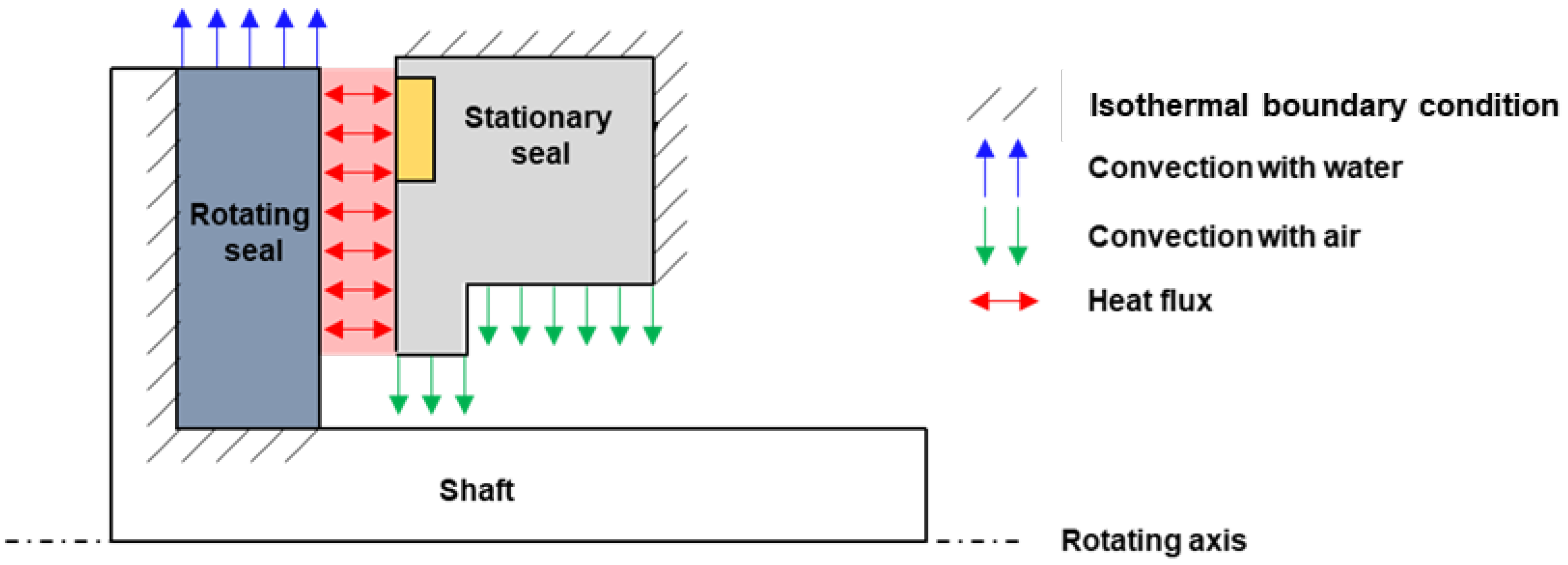
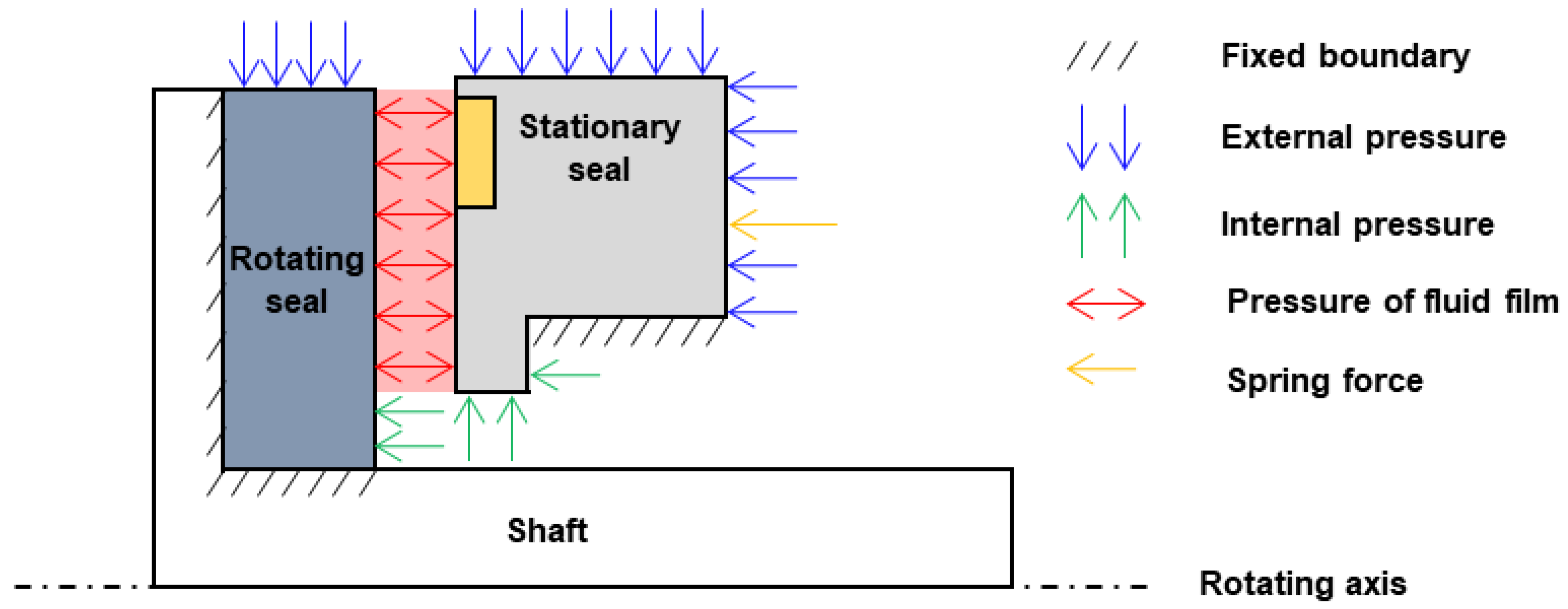

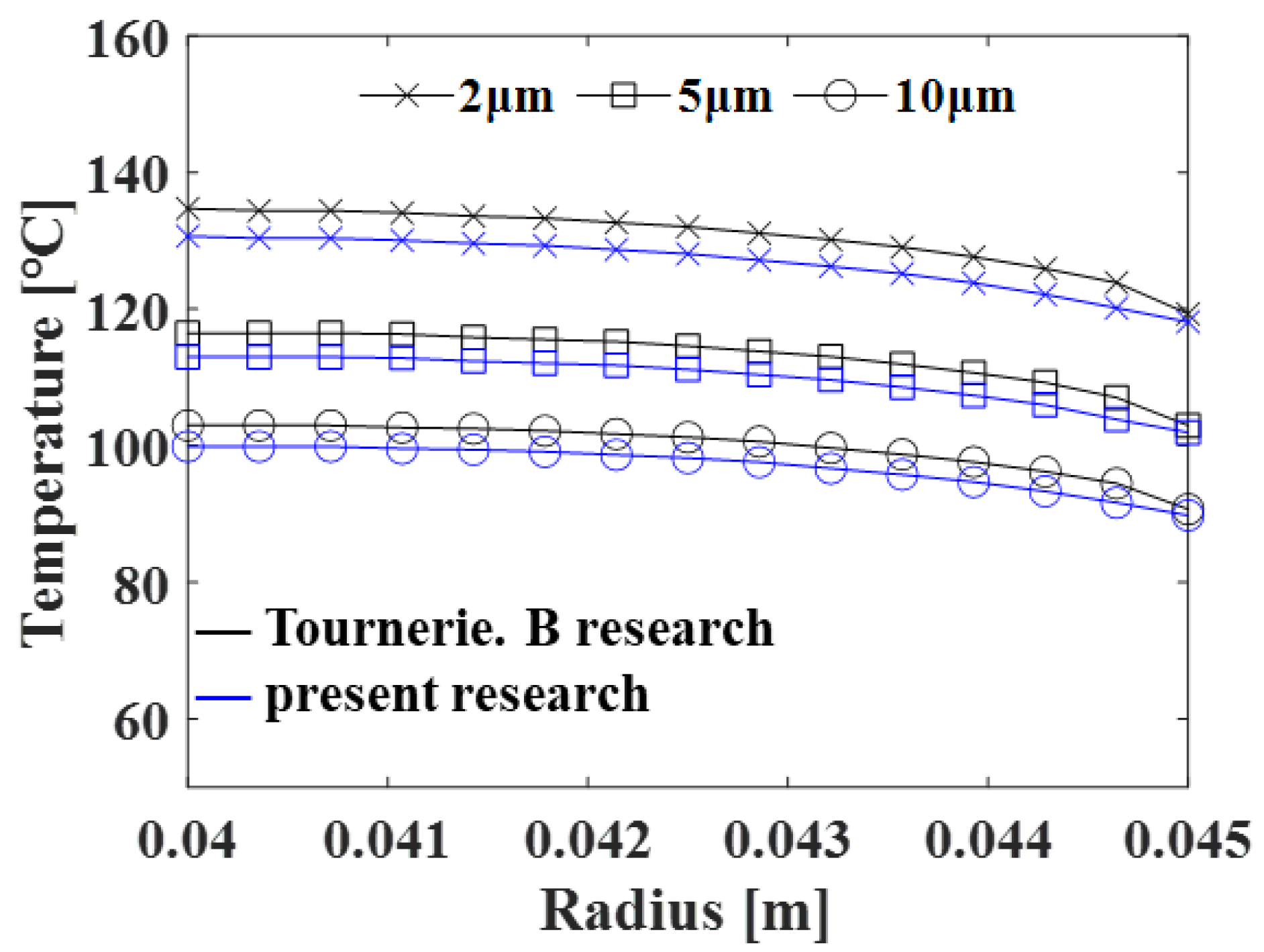
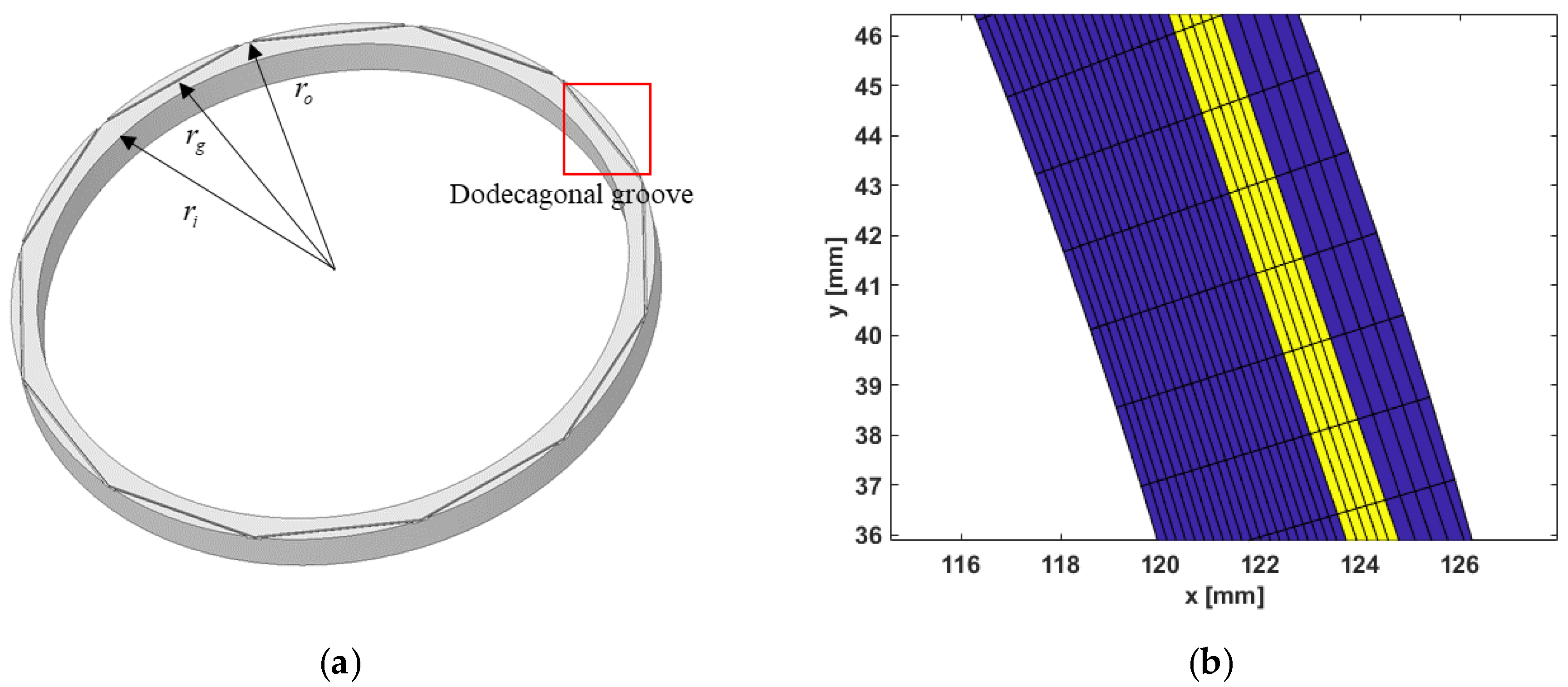


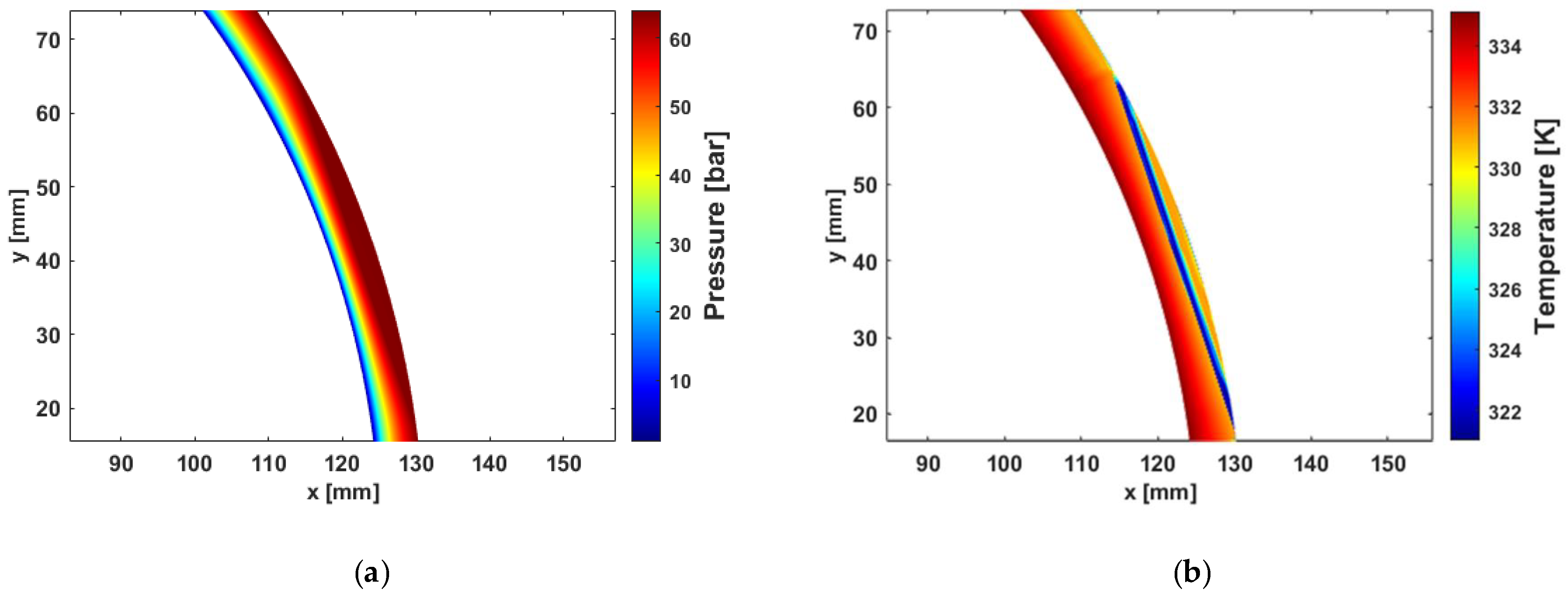

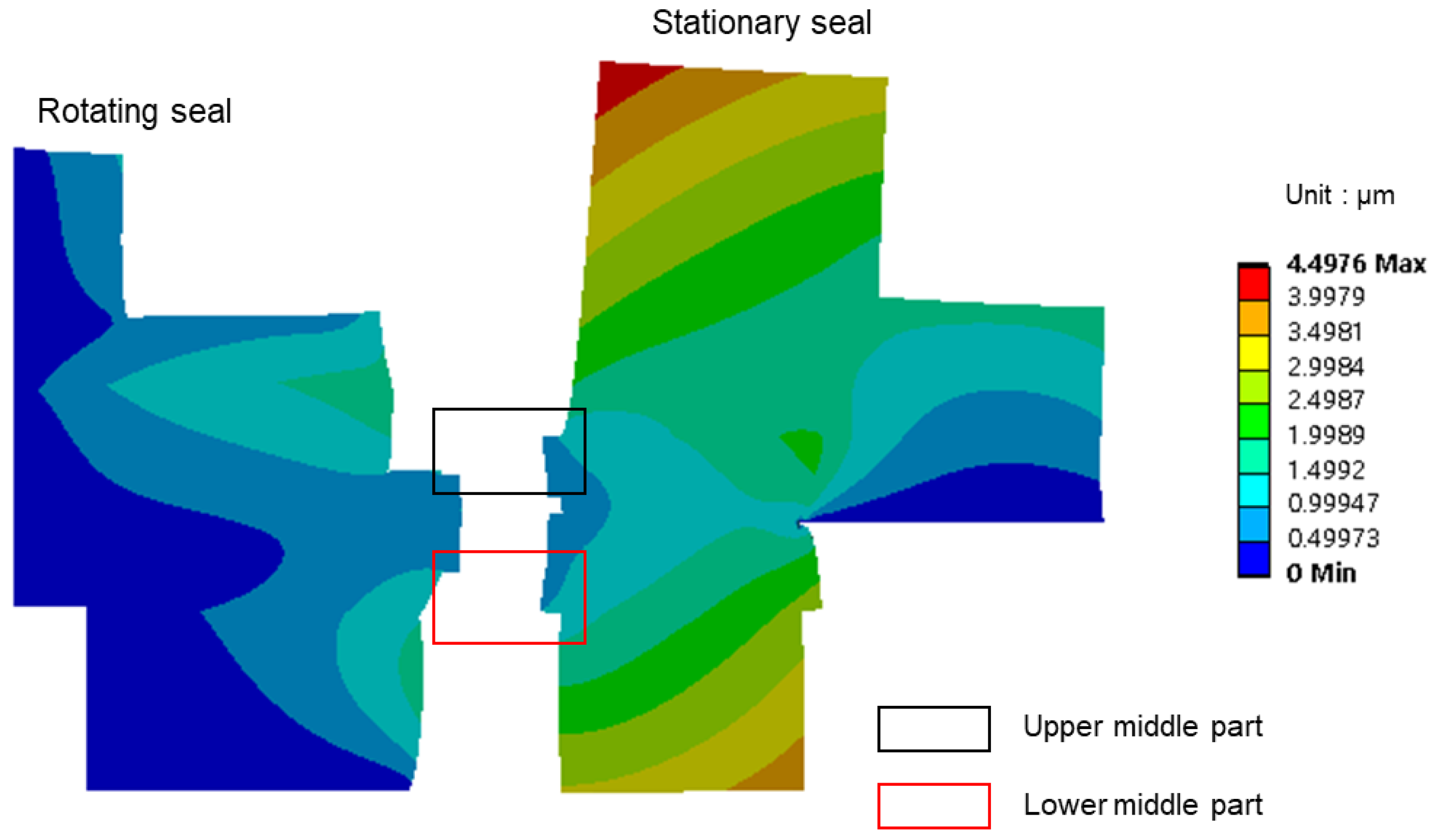
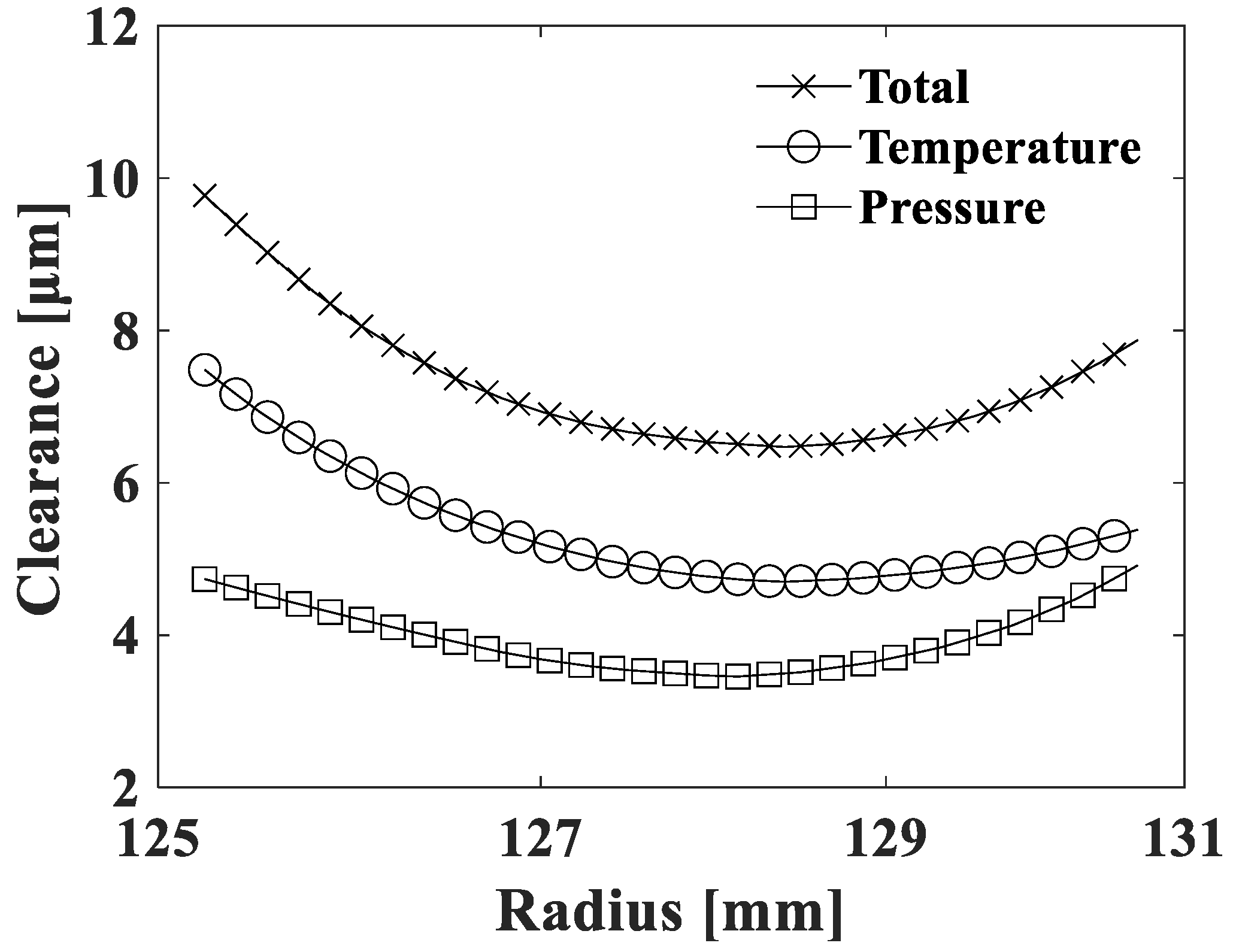
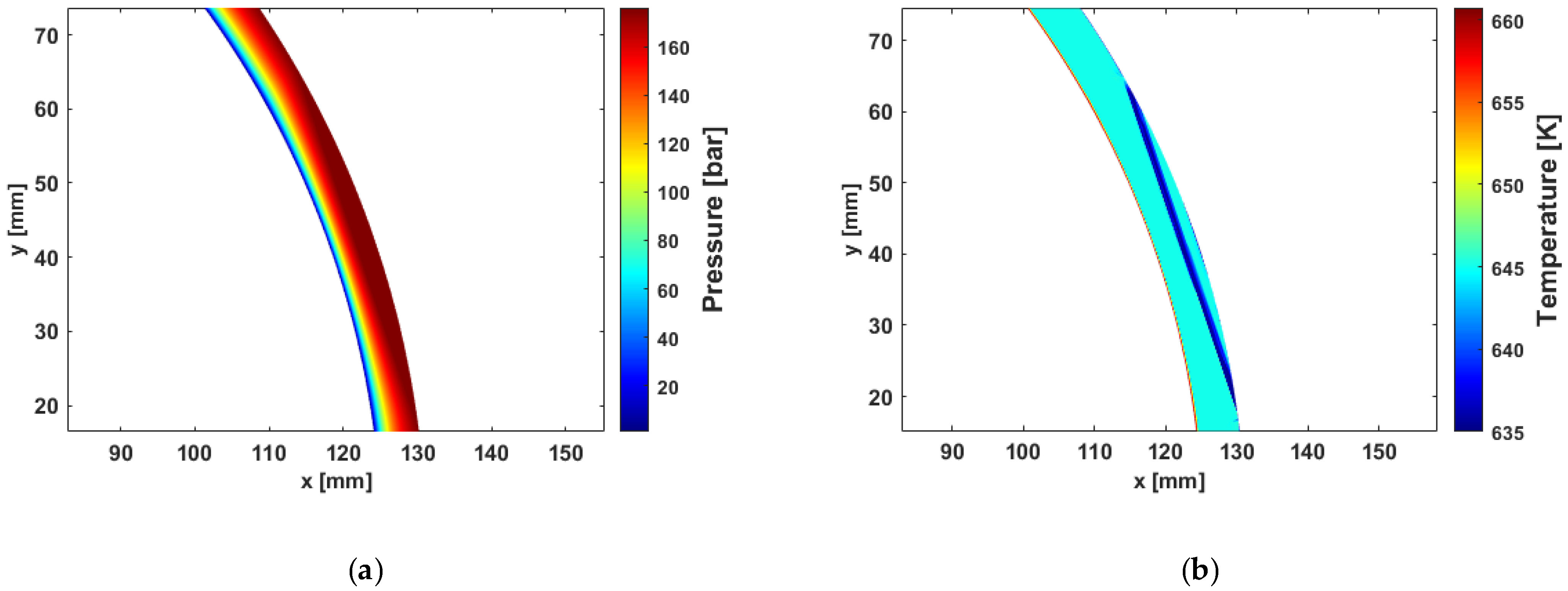

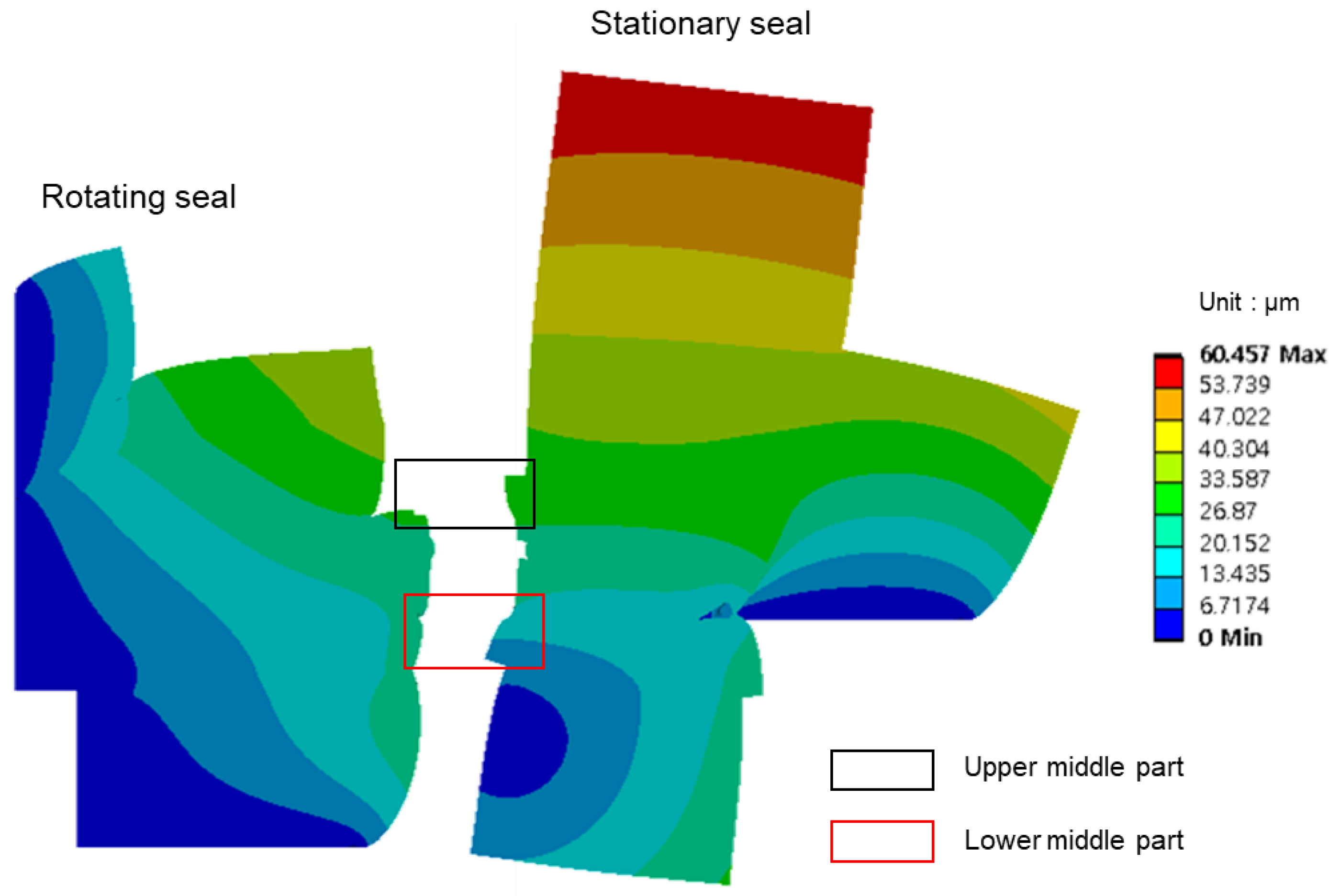
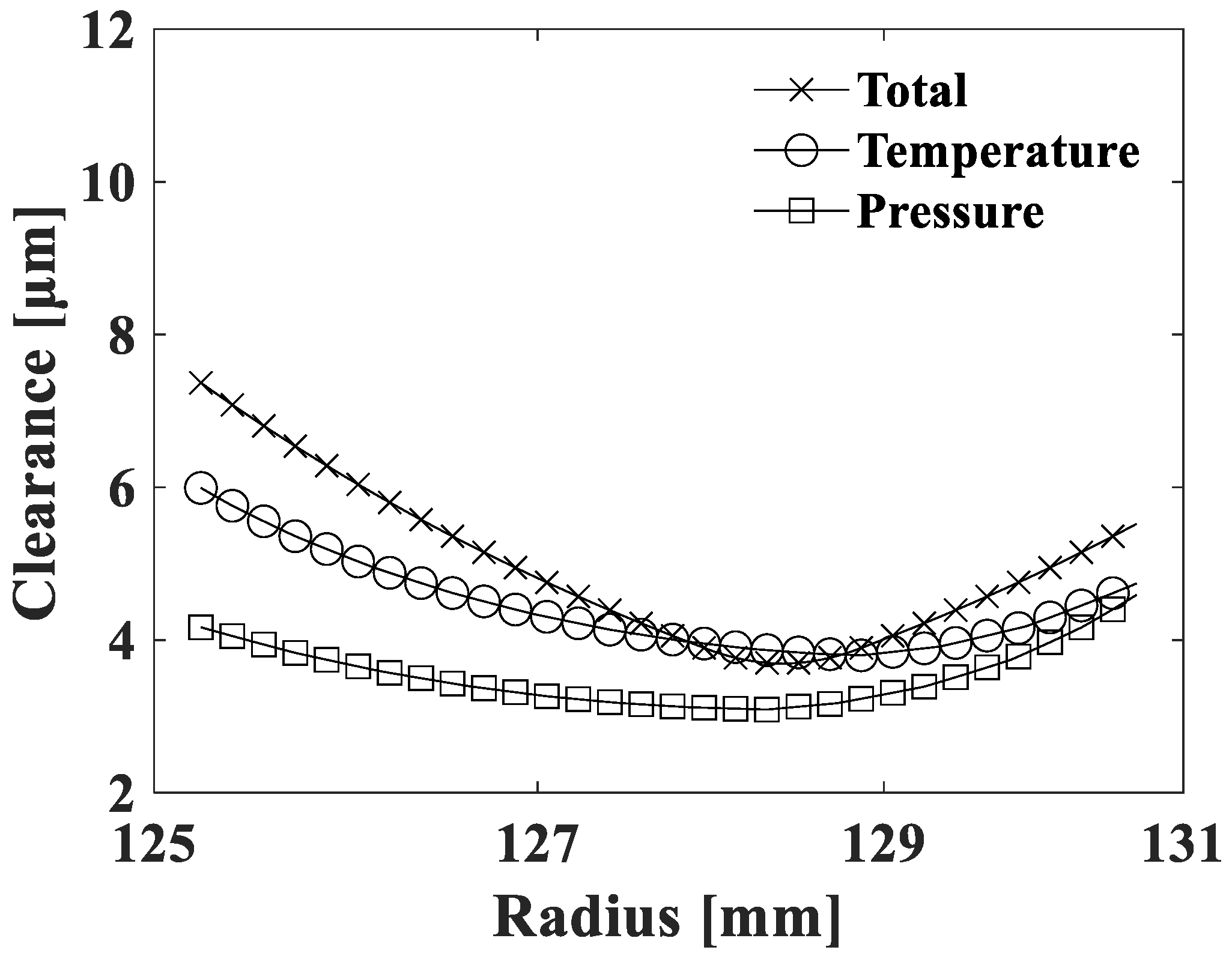
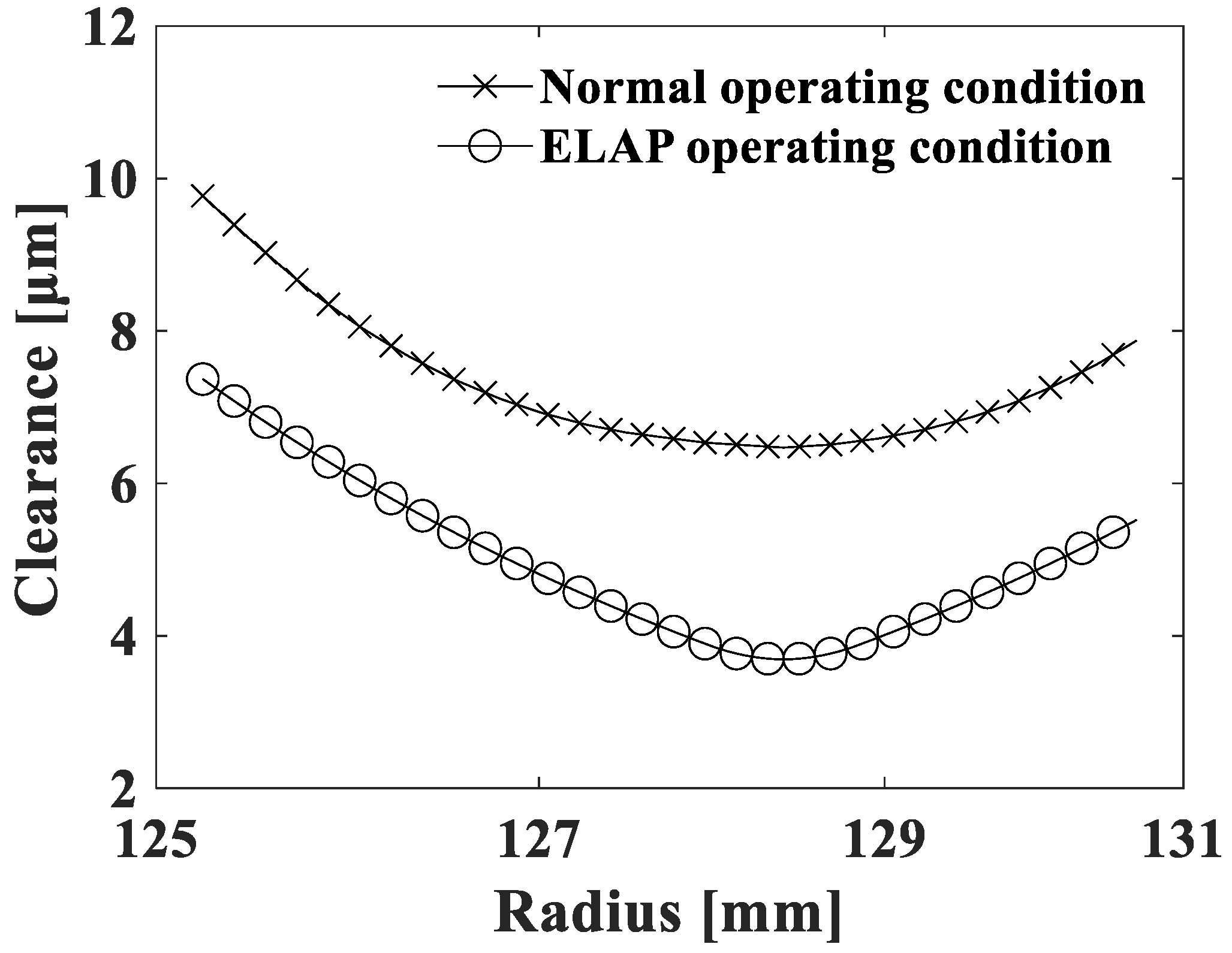
| Parameter | Value |
|---|---|
| Outer radius, ro [mm] | 131 |
| Groove radius, rg [mm] | 128.7 |
| Inner radius, ri [mm] | 125 |
| Balance radius, rb [mm] | 127 |
| Radial groove length [mm] | 1 |
| Number of grooves [ea] | 12 |
| Groove depth [mm] | 1 |
| Fluid specific heat capacity, Cp [J/kgK] | 4184 |
| Fluid thermal conductivity, k [W/mK] | 0.592 |
| [rpm] | 1200 |
| Parameter | Normal Condition | ELAP Condition |
|---|---|---|
| External pressure, po [bar] | 64 | 176 |
| Internal pressure, pi [bar] | 1 | 1 |
| Seal fluid temperature, To [K] | 313 | 583 |
| Ambient temperature, Ti [K] | 313 | 583 |
| Fluid density, ρ [kg/m3] | 995.02 | 709.76 |
| Fluid viscosity, μ [μPas] | 655.38 | 85.44 |
| Parameter | Carbon Graphite | Silicon Carbide |
|---|---|---|
| Density, ρr [kg/m3] | 1800 | 3100 |
| Young’s modulus [GPa] | 25 | 400 |
| Poisson’s coefficient | 0.2 | 0.17 |
| Specific heat capacity, Cpr [J/kgK] | 710 | 400 |
| Thermal conductivity, kr [W/mK] | 15 | 150 |
| Linear thermal expansion coefficient [/10−6 °C] | 4 | 4.3 |
Disclaimer/Publisher’s Note: The statements, opinions and data contained in all publications are solely those of the individual author(s) and contributor(s) and not of MDPI and/or the editor(s). MDPI and/or the editor(s) disclaim responsibility for any injury to people or property resulting from any ideas, methods, instructions or products referred to in the content. |
© 2024 by the authors. Licensee MDPI, Basel, Switzerland. This article is an open access article distributed under the terms and conditions of the Creative Commons Attribution (CC BY) license (https://creativecommons.org/licenses/by/4.0/).
Share and Cite
Park, Y.; Hong, G.; Jun, S.; Choi, J.; Kim, T.; Kang, M.; Jang, G. Thermo-Fluid–Structural Coupled Analysis of a Mechanical Seal in Extended Loss of AC Power of a Reactor Coolant Pump. Lubricants 2024, 12, 212. https://doi.org/10.3390/lubricants12060212
Park Y, Hong G, Jun S, Choi J, Kim T, Kang M, Jang G. Thermo-Fluid–Structural Coupled Analysis of a Mechanical Seal in Extended Loss of AC Power of a Reactor Coolant Pump. Lubricants. 2024; 12(6):212. https://doi.org/10.3390/lubricants12060212
Chicago/Turabian StylePark, Youngjun, Gwanghee Hong, Sanghyun Jun, Jeongmook Choi, Taegyu Kim, Minsoo Kang, and Gunhee Jang. 2024. "Thermo-Fluid–Structural Coupled Analysis of a Mechanical Seal in Extended Loss of AC Power of a Reactor Coolant Pump" Lubricants 12, no. 6: 212. https://doi.org/10.3390/lubricants12060212
APA StylePark, Y., Hong, G., Jun, S., Choi, J., Kim, T., Kang, M., & Jang, G. (2024). Thermo-Fluid–Structural Coupled Analysis of a Mechanical Seal in Extended Loss of AC Power of a Reactor Coolant Pump. Lubricants, 12(6), 212. https://doi.org/10.3390/lubricants12060212






